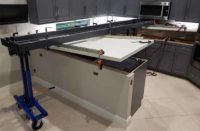
Avoiding certain pitfalls can mean the difference between a struggling hobby and a thriving business. When it comes to countertops, here are a few of the most common mistakes we at the Concrete Countertop Institute think are the biggest stumbling blocks for aspiring concrete countertop contractors.
Mistake #1: Lack of communication with your clients.
It’s vital you explain what you are providing to your client and how your concrete will perform. Communication goes beyond setting expectations and includes project communication about what to expect before, during and after the job is done. To avoid this mistake:
- Know exactly how your sealer performs in terms of staining, scratching and heat, and have a printed handout for prospects.
- Put the performance characteristics in your contract.
- Use a templating checklist and an installation checklist that you send to the client or contractor before you go to template or install.
Mistake #2: Experimenting on your client.
It’s good to incorporate new products, technologies and innovations into your concrete countertops if you need to make improvements. However, it’s in your best interest to research those products and test their performance thoroughly before ever using them on a client.
It’s also tempting to constantly change things in an attempt to improve them. But if you can’t demonstrate a real and positive change that will directly benefit your client and/or save you money in the long run, then don’t fall into the trap of “fixing” something that isn’t broken. To avoid this mistake:
- Once you have a mix design and sealer that do what you want and don’t cause your clients problems, don’t change them unless necessary.
- Any change you make should be justified by a clear business need that reduces costs, increases profits or results in higher client satisfaction.
- Any change you make should be thoroughly tested before using it on client projects.
Mistake #3: Making mistakes!
Making technical mistakes in the process of creating concrete countertops is expensive. It’s not just the cost of the materials, it’s the time involved. Consider the lost time in redoing a job and the lost business from not being able to take on new projects.
Most mistakes happen because you have a hard time keeping up with all of the details. Develop quality checklists for every step of a project, and have your employees — and you — use them consistently. To avoid this mistake:
- Every project should have a job folder that contains all of the pertinent information about the job, including a detailed project description, checklists, client contact information and schedule.
- Don’t rush. Spending a few minutes thinking through the best way to do something can save many hours later.
- Don’t let a client rush you. Say no when asked if you can start forming before the sink is available. Say no when asked if you can just use the drawings and skip the physical template. Don’t speed up a project by taking shortcuts.
Mistake #4: Not using a contract.
Doing business without a contract is like driving an uninsured vehicle while not wearing a seatbelt. Contracts don’t scare off clients and they don’t limit creativity. A clearly written contract shows that you’re a professional who has thought out all of the details and is looking out for the best interest of the client. To avoid this mistake:
- Know what the legal or permitting requirements are in your state. In some states a contract is legally required for jobs more than a certain dollar amount, and in some states the content of the contract is regulated.
- Use a contract that clearly states all of your and the client’s obligations, a detailed project description, payment schedule, remediation options, a warranty and performance expectations. Use it for every project.
Mistake #5: Running your business like a hobby.
A hobby is something you do to have fun that costs you money. A business is something you do to make money and that you enjoy (hopefully). Not all parts of a business are going to be fun, but you must balance the fun and the work to focus on the end result. To avoid this mistake:
- Mark Twain said, “Eat a live frog first thing in the morning and nothing worse will happen to you all day.” Do what you need to do to build your business, even if it’s not fun.
- Have a clear business need for every sample, color, shape or experiment you do and every piece of equipment you purchase.
- Plan ahead in materials ordering to save big on shipping.
Mistake #6: Neglecting marketing.
You took a class, got the tools and have spent the last six months making samples. Now you simply have to sit back and wait for the customers to call. After all, if you build a better mouse trap the world will beat a path to your door. Right?
Wrong! That old adage is a fallacy. Being successful in business means you actively seek out customers and educate them in what you offer. They won’t know who you are, what you can do or why they should choose you instead of your competition unless you actively market your business. To avoid this mistake:
- Don’t be scared of marketing. Simply networking and handing out your cards is marketing. Having a website is marketing. Marketing is anything and everything you do to build awareness and get prospects to become interested in your offerings.
- Use relationship marketing. Learn how to work with the influencers such as kitchen designers and architects to leverage your marketing efforts.
- Be frugal with money on print ads, until you’ve already worked through free marketing techniques and can afford expensive ads.
Mistake #7: Making your concrete countertops look like floors.
Floors belong in the decorative concrete industry. Concrete countertops belong in the kitchen and bath industry. Sure, they are made out of concrete and have color and other nuances, but their fit, finish, functionality and performance all get compared to other countertop materials.
Floors are seen from a distance, whereas countertops are literally closer than arm’s length. A single sealer drip that is nearly invisible on a floor becomes a glaring defect on a countertop. To avoid this mistake:
- Find a good performance sealer that you can learn how to apply to get a perfect finish.
- Learn what high-end countertops look like. Subscribe to high-end design magazines. Visit high-end kitchen design showrooms in your area.
Use the tips in this article and you’ll avoid problems, sell more countertops, have happier clients and ultimately have a more profitable, less stressful business.















